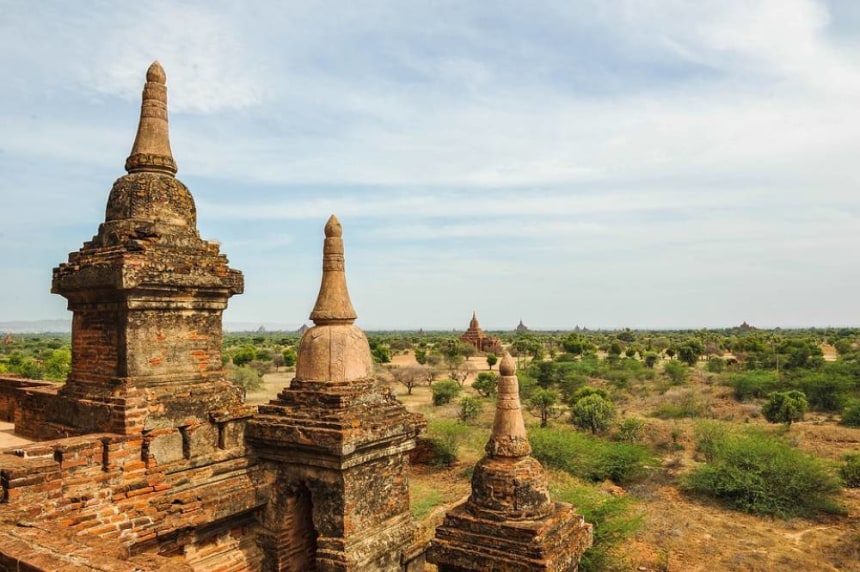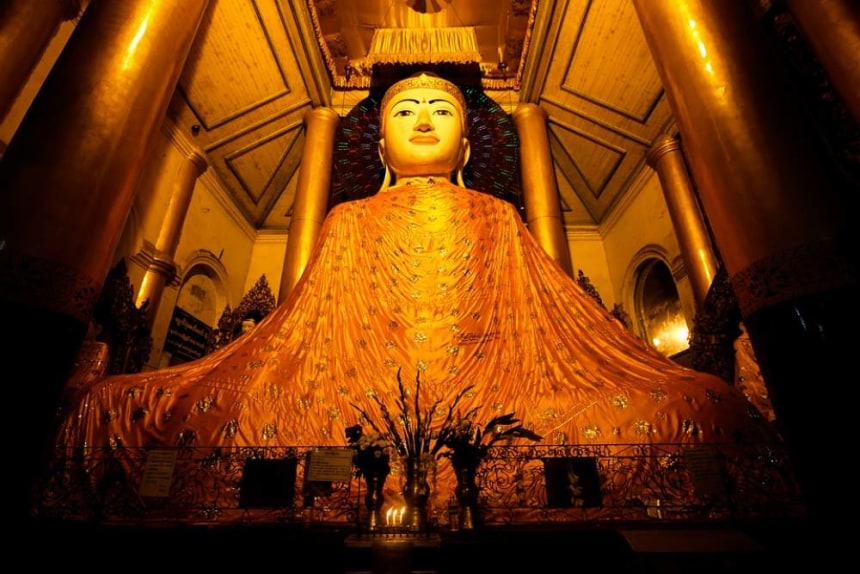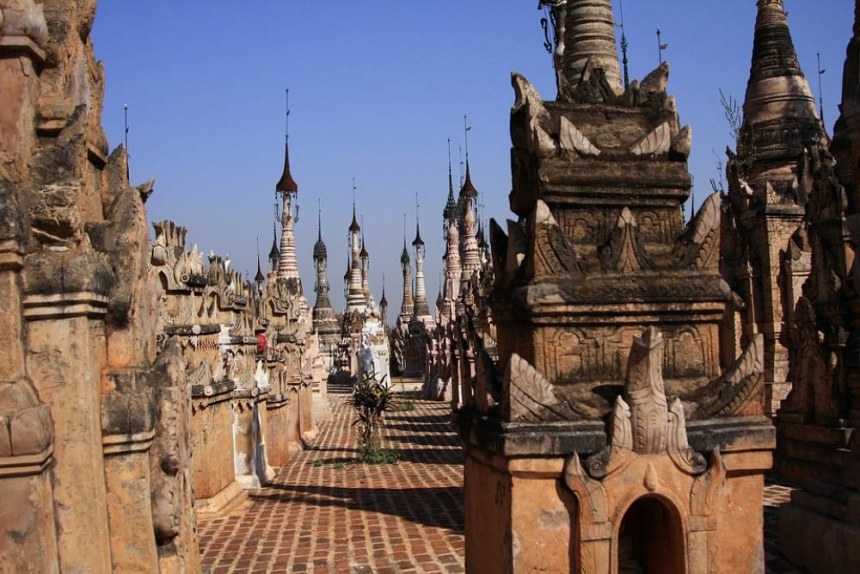
Shwezigon Paya (built late 11th century)
The Shwezigon Paya (pagoda, stupa or zedi), is one of the Bagan area's, and Myanmar's, most significant religious structures. Located four miles northeast of Old Bagan at the edge of the most important regional town of Nyaung U (or Nyaung Oo), it truly is a 'National' pagoda, since it served as a prototype for many later stupas built throughout Myanmar. The Shwezigon is also a major national center of worship. Pilgrims come from many parts of Myanmar for its festival held during the Burmese month of Nadaw (November/December) both because of its historic character and because of its religious significance for Burmese Buddhism.
While the Shwezigon was one of the earliest symbols of the triumph of the 'purified' Theravada Buddhism, it was also the first pagoda to allow nat images (pre-Buddhist spirits who had the power to do good or evil) within its walls. Its original builder, King Anawrahta (r. 1044-1077), even had images of the 37 traditional nats put on the lower terraces. As a result nat worship joined for the first time with the nascent Theravada Buddhism to form a unique and vibrant Burmese religious experience that also contributed to the general growth of Theravada. Eventually the nats of Shwezigon were removed from the terraces to a small hall within the compound, but the Shwezigon Festival still brings multitudes to honor and worship the nats at Shwezigon.
King Anawrahta's conversion to Theravada Buddhism in the mid-11th century had a profound influence on Bagan's religious and cultural life. Anawrahta was Theravada's first major advocate; he was also the first of the great builders of Bagan. He began construction of the Shwezigon (on a site reputedly chosen by a white elephant) as a massive and centrally important reliquary shrine to encase a variety of Buddha artifacts, including a copy of the Tooth of Kandy from Ceylon, frontal and collar bones, and an emerald Buddha image from China. Apparently he had completed the three terraces before he (perhaps) was killed by a wild buffalo in 1077; some contend that he had even completed a small stupa on the terraces and had plans to encase it in a larger structure.
The reliquary shrine was completed between 1086 and 1090 by King Kyanzittha (r. 1084-1113), Anawrahta's probable son (the parentage question remains dubious). Kyanzittha was perhaps Bagan's greatest king, and it was under him that Bagan became known, doubtless with a touch of exaggeration, as the 'city of four thousand pagodas.' He did erect hundreds of monuments and also successfully championed the Mon Buddhist culture. When the symbolic hti, or umbrella, was put into place over the Shwezigon in 1090, the reliquary shrine had essentially taken on the shape that it has today. Earthquakes and other natural phenomena have, of course, taken their toll over the centuries, and it has been often repaired, perhaps most notably by King Bayinnaung (r. 1551-1581) in the late 16th century. The recent devastating earthquake of 1975 caused extensive damage to the spire and top of the dome that needed extensive repairs. Each attack on its main fabric doubtless introduced subtle and not-so-subtle changes to the structure. The pagoda, for example, now is encased by over 30,000 copper plates made possible through donations by local, national and international visitors. The entire structure was gilded in 1983-1984 and again more recently. Yet the lower part of the stupa and terraces apparently remain largely as originally constructed in the 11th century.
The Paya is a solid symmetrical stupa oriented to the east; it is built of sandstone blocks that average approximately 15 x 10x 3 in. (38 x 26 x 8 cm). Its gracefully shaped 'bell' or 'anda' reaches a height of 160 ft. and sets on an intermediate octagonal base and on three rising square terraces accessible from the four cardinal points. Each of these terraces has 'Jataka' tablets relating the life of the Buddha. Smaller stupas mirror the main stupa at the corners of each terrace. The square base of the stupa matches the height of the stupa at 160 ft on each side. There is a wide variety of decorations and thick circular moldings on the bell itself, and the central spire is crowned by the traditional hti, or umbrella, a symbol of sovereignty.
In front of each of the axial stairways leading to the terraces are square satellite temples with central shrines that were integrally planned to be part of the total mass. Each shrine (or Kyay Gu Taik) contains an 11 ft Gupta-style standing gilded bronze Buddha (the largest original statues in Bagan) dating from the early 12th century. The four represent the Buddhas who attained enlightenment in this world: Kakusana, Konagom, Kassapa and Gotama.
The Shwezigon is located at the center of an enclosure wall, roughly 750 ft (230 m) on each side, that is penetrated by four gates. There is a large and varied number of shrines, monuments, smaller zedi and temples within the enclosure walls. They date from numerous eras, and more are regularly added. On the eastern side two inscribed pillars placed there by King Kyanzittha record the pagoda's history in the Mon language. Interestingly, the inscription does not mention King Anawrahta, who started the construction in the mid-11th century.
Text by Robert D. Fiala, Concordia University, Nebraska
Location
The approximate location of the site is 21.195345' N, 94.893883' E (WGS 84 map datum).




